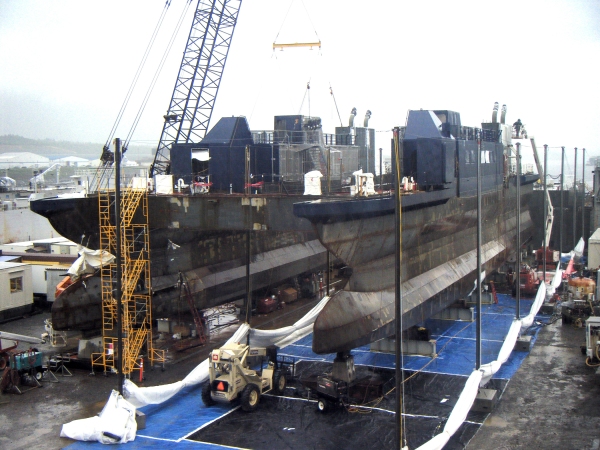The Navy’s Transforming E-Craft

The Office of Naval Research E-Craft, an experimental high-speed transformable hull form vessel, is under construction at Alaska Ship and Drydock in Ketchikan, Alaska.
The MV Susitna catamaran ferry is an interesting concept similar to the Navy’s current fleet of catamaran vessels with one remarkable difference, it has the ability to transform from a deep water transport to a shallow draft vessel, specifically into 3 distinct modes of barge, catamaran and SWATH (small waterplane area twin hull) ship. From the Office of Naval Research:
The ship will have a center “barge” that can be hydraulically raised and lowered; it also will have the option to adjust the buoyancy of its catamaran hulls while under way. The vessel will demonstrate the functionality of a ship that can provide a multipurpose, expeditionary cargo and troop ship that performs efficiently at high speed, in ice, and in shallow waters, and that can even beach itself to load/discharge vehicles up to tank size.
The vessel will have three distinct modes of operation: a catamaran mode for high speeds; a small-water-area-twin-hull (SWATH) mode for stability in high sea states; and a shallow-draft landing-craft mode that provides substantial buoyancy for maneuvering in shallow water. In addition, the Susitna will be the world´s first ice-breaking twin-hulled vessel.
Also interesting is the partnership with commercial industry to see the project to fruition. The Navy is in league with the Matanuska-Susitna Borough, and Alaska Ship & Drydock, with the funds coming from the ONR. When launched, the ferry will operate between Anchorage, Alaska and Port Mackenzie in its civil guise while the Navy takes notes.
Naturally the government is interested in MV Susitna’s military applications, and potentially these are considerable. The Navy sees it as key for its expeditionary/amphibious warfare sea basing plans, hence the official moniker of “E-craft”. This is also where its transforming abilities come to play, allowing it to morph into a shallow-water “Sealifter” quickly from its Blue Water transport mode. Global Security explains this concept:
The E-Craft is a variable-draft vessel that includes a center hull; a first side hull coupled to a first side of the center hull; a second side hull coupled to a second side of the center hull; and at least one cross support coupling the first and second side hulls, wherein the center hull is configured to be vertically translated with respect to the first and second side hulls. According to a specific embodiment, the vessel further includes lifting mechanism configured to vertically translate the center hull with respect to the first and second side hulls. The lifting mechanism may include a plurality of hydraulic actuators coupled between the center hull and the first and second side hulls…
The center hull may be raised above the water, thereby forcing the side hulls relatively deep into the water (i.e., relatively deep draft)…In deep-draft-transit mode, the height of the center hull may be adjusted such that a top deck of the center hull approximately matches, for example, the height of a pier or the like…When each of the side hulls and the center hull are in the water, the configuration of the vessel is referred to as the shallow-draft mode. As each of the three hulls is in the water, the hull form is similar to flat-bottomed-monohull vessels and has a relatively high buoyancy and relatively low draft.
In our view, we see the E-craft along with the other high speed catamarans such as the HSV-2 Swift built by Incat from a catamaran ferry design, as the future of amphibious warfare. As the techniques now stands in the US and other large navies, the idea of amphibious warfare is for very large and costly “motherships” to act as a go-between to the actual landing vessels to get the Marines and their cargo to shore. By doing away with this very costly, large and vulnerable “middleman”, shallow draft ferries would carry the troops from a port of embarkation to the landing zone directly and very quickly. Naturally such a strategy would entail the purchase of very many such craft to match the current lifting abilities of large Amphib ships, but historically in wartime conditions, many ships are more desirable and ensures than some will survive to perform their essential mission, by not placing all your precious expeditionary assets in a few giant hulls.
E-craft also has considerable arctic abilities, able to sail through 2 feet of ice. We wonder if this might also be of interest to our Canadian friends, currently searching for arctic patrol vessels?
Here is the MV Susitna’s specifications:
· Length -195 Feet, Beam – 60 feet
· Displacement: 940 tons full load
· Variable Draft – SWATH mode is 12± feet, shallow-draft landing-craft mode is 4± feet.
· Capacity: 100 Passengers and 20 vehicles.
· Speed: 20 knots
· Power Plant: 4 ea., MTU 12V 4000 diesel engines
The vessel is scheduled for delivery in April 2010. The Matanuska-Susitna Borough also has a website on the E-craf